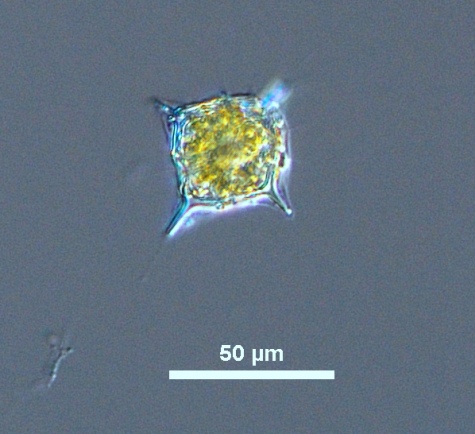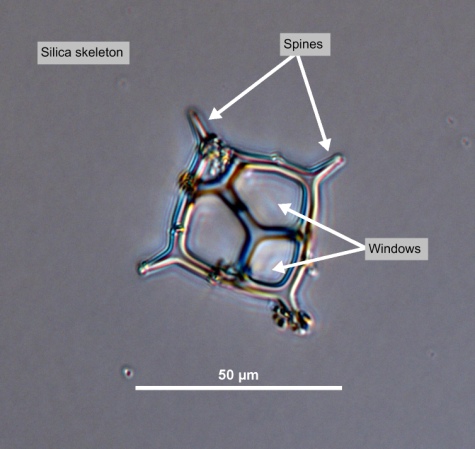



|
Synonym(s)
Classification
(Guiry and Guiry 2011)
Lifestyle
Isogamy
The simplest type of sexual reproduction between gametes that are similar in size and shape. Instead of being classified as male and female cells, organisms of different mating types (i.e., different size and shape of gamete) can fuse to form a zygote (Botany Dictionary 2002).
isogamy. Asexual reproduction by CloseAplanospore
A thin-walled spore that relies on water currents for passive transport. It is produced by some phytoplankton (including Scenedesmus and Geminella species [phylum Chlorophyta]) as a means of asexual reproduction. Upon germination, it develops a new cell wall distinct from the parent cell. The production of aplanospores may be a hereditary feature or may be an adaptation to withstand unfavourable environmental conditions (Transeau 1916).
aplanospores and CloseStatospore
An internally formed spore in its resting stage. A thick-walled, resistant spore formed within the frustules of various centric diatoms.
statospores (Guiry 2011). Naked, swimming stage and non-swimming CloseCoenocyte
A multinucleate cell originating either from multiple nuclear divisions without accompanying cell division or from cellular aggregation and dissolution of the cell membranes inside the mass (DeWreede 2006).
coenocytes were found in clonal cultures at 15 °C (Van Valkenberg and Norris 1991).Description
Discoid
Disc-shaped.
discoid chloroplasts (Horner 2002).Pseudopodium/pseudopodia
A semi-permanent extension of the cytoplasm used for locomotion and feeding by some flagellate protozoans.
pseudopodia (Kraberg et al. 2010).Measurements
(Kraberg et al. 2010)
Similar species
Harmful effects
Habitat
Distribution
Warm to cold seas (Horner 2002).
Most abundant during the winter-spring transition in Western Mediterranean (Rigual-Hernandez et al. 2010). Can be found occasionally throughout the year (Kraberg et al. 2010).
Information not available.
Growth conditions
Lux
(abbreviated 'lx') Units for measuring light intensity in a given surface area.
lux) illumination in culture. D. fibula is unable to grow at temperatures above 15 °C (Van Valkenberg and Norris 1991).Nutrients
Various chemical substances that an organism needs for metabolism (i.e., to live and grow). These are usually taken up from the environment. Some examples include nitrate, phosphate, silica (for diatoms), iron, copper, etc. Some nutrients, like copper, are required for growth, but can also be toxic at high levels.
nutrient-rich euphotic layer and the increase in solar radiation. Minimum abundances occur during the summer due to strong CloseOligotrophic
Describing an aquatic ecosystem with low nutrient and organic matter accumulation and high dissolved oxygen content.
oligotrophic (low nutrients, high oxygen) and CloseStratification
The development of distinct non-mixing layers in the water column resulting from a steep gradient in density, which is caused by differences in temperature and/or salinity.
stratification conditions. Also very sensitive to nutrient inputs, reaching maximums where river influence is important (Rigual-Hernandez et al. 2010).Environmental Ranges
Temperature range (°C): -1.857 - 26.001
Nitrate (μmol L-1): 0.135 - 13.138
Salinity (PSU): 25.320 - 36.252
Oxygen (mL L-1): 4.705 - 9.002
Phosphate (μmol L-1): 0.048 - 1.562
Close
Silicic acid
A general term to describe chemical compounds containing silicon, oxygen and hydrogen with a general formula of [SiOx(OH)4-2x]n. Diatoms polymerize silicic acid into biogenic silica to form their frustules (Azam and Chisholm 1976).
Silicate (μmol L-1): 0.754 - 33.908(OBIS 2011, cited in EOL 2011)
Bloom characteristics
References
Encyclopedia of Life. 2011. Dictyocha fibula Ehrenberg. http://www.eol.org/pages/900748. Accessed 02 Jul 2011.
Guiry, M. D. 2011. Dictyocha fibula Ehrenberg, 1837. World Register of Marine Species at http://www.marinespecies.org/aphia.php?p=taxdetails&id=157463 Accessed 02 Jul 2011.
Guiry, M. D. and Guiry, G. M. 2011. Dictyocha fibula Ehrenberg. http://www.algaebase.org/search/species/detail/?species_id=52816. Accessed 02 Jul 2011.
Haigh, N. 2010. Harmful Plankton Handbook. Nanaimo, BC, Canada. 52.
Horner, R. A. 2002. A Taxonomic Guide To Some Common Phytoplankton. Biopress Limited, Dorset Press, Dorchester, UK. 200.
Kraberg, A., Baumann, M. and Durselen, C. D. 2010. Coastal Phytoplankton: Photo Guide for Northern European Seas. Verlag Dr. Friedrich Pfeil, Munchen, Germany. 204.
Ocean Biogeographic Information System (OBIS). 2011. Dictyocha fibula. http://www.iobis.org/mapper/?taxon_id=434071. Accessed 02 Jul 2011.
Rigual-Hernandez, A. S., Barcena, M. A., Sierro, F. J., Flores, J. A., Hernandez-Almeida, I., Sanchez-Vidal, A., Palangues, A. and Heussner, S. 2010. Seasonal to interannual variability and geographic distribution of the silicoflagellate fluxes in the Western Mediterranean. Marine Micropaleontology. 77(1-2): 46-57.
Throndsen, J. 1997. The planktonic marine flagellates. In: Tomas, C. R. (ed.) Identifying marine Phytoplankton. Academic Press, Inc., San Diego, California, US. 591-730.
Van Valkenburg, S. D. and Norrise, R. E. 1970. The growth and morphology of the silicoflagellate Dictyocha fibula Ehrenberg in culture. Journal of Phycology. 6: 48-54.
Vila, M. and Maso, M. 2005. Phytoplankton functional groups and harmful algal species in anthropogenically impacted waters of the NW Mediterranean Sea. Scientia Marina. 69(1): 31-45.
